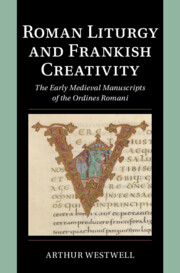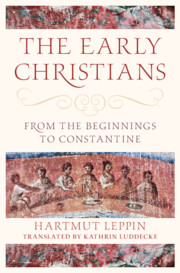47 results
Bishops in the House of Lords: fit for the future?
-
- Journal:
- Ecclesiastical Law Journal / Volume 26 / Issue 2 / May 2024
- Published online by Cambridge University Press:
- 09 May 2024, pp. 147-180
- Print publication:
- May 2024
-
- Article
-
- You have access
- HTML
- Export citation
Chapter 2 - Urban Contexts for Popular Culture in an Age of Transformation
-
- Book:
- Popular Culture and the End of Antiquity in Southern Gaul, c. 400–550
- Published online:
- 15 March 2024
- Print publication:
- 28 March 2024, pp 36-72
-
- Chapter
-
- You have access
- HTML
- Export citation
Chapter 1 - The ‘Roman’ Collection of Ordines in Metz, Lorsch and Tours
- from Part I - Compilation and Content of the Manuscripts
-
- Book:
- Roman Liturgy and Frankish Creativity
- Published online:
- 04 January 2024
- Print publication:
- 18 January 2024, pp 19-39
-
- Chapter
-
- You have access
- HTML
- Export citation
Chapter 2 - The ‘Frankish’ Collection of Ordines in Verona, Regensburg, Nonantola and Corbie
- from Part I - Compilation and Content of the Manuscripts
-
- Book:
- Roman Liturgy and Frankish Creativity
- Published online:
- 04 January 2024
- Print publication:
- 18 January 2024, pp 40-51
-
- Chapter
- Export citation

Roman Liturgy and Frankish Creativity
- The Early Medieval Manuscripts of the Ordines Romani
-
- Published online:
- 04 January 2024
- Print publication:
- 18 January 2024
Looking Back and Ahead
-
- Book:
- The Early Christians
- Published online:
- 05 October 2023
- Print publication:
- 26 October 2023, pp 368-393
-
- Chapter
- Export citation
Chapter 2 - Christian Authorities
-
- Book:
- The Early Christians
- Published online:
- 05 October 2023
- Print publication:
- 26 October 2023, pp 116-222
-
- Chapter
- Export citation
Chapter 6 - Christianity and Paganism in the Iohannis
-
- Book:
- War, Rebellion and Epic in Byzantine North Africa
- Published online:
- 12 October 2023
- Print publication:
- 26 October 2023, pp 216-257
-
- Chapter
- Export citation

The Early Christians
- From the Beginnings to Constantine
-
- Published online:
- 05 October 2023
- Print publication:
- 26 October 2023
A Limited Episcopacy? Canon Law and the Ministry of the ‘Episcopal Assistant’ in the Anglican Communion
-
- Journal:
- Ecclesiastical Law Journal / Volume 25 / Issue 3 / September 2023
- Published online by Cambridge University Press:
- 05 September 2023, pp. 359-373
- Print publication:
- September 2023
-
- Article
- Export citation
Pope Francis’ Vision for a Synodal Church
-
- Journal:
- New Blackfriars / Volume 104 / Issue 1113 / September 2023
- Published online by Cambridge University Press:
- 01 January 2024, pp. 511-525
- Print publication:
- September 2023
-
- Article
-
- You have access
- Open access
- HTML
- Export citation
Kenotic Ecclesiology and the Disestablishment of the Church of England under the Reign of Charles III
-
- Journal:
- Journal of Anglican Studies / Volume 22 / Issue 1 / May 2024
- Published online by Cambridge University Press:
- 03 July 2023, pp. 234-250
-
- Article
- Export citation
9 - Bishops
-
-
- Book:
- The Cambridge Companion to the Council of Trent
- Published online:
- 02 October 2023
- Print publication:
- 16 March 2023, pp 180-208
-
- Chapter
- Export citation
Chapter 1 - The Makings of an English Multinational
-
- Book:
- The Dominicans in the British Isles and Beyond
- Published online:
- 02 March 2023
- Print publication:
- 09 March 2023, pp 11-65
-
- Chapter
- Export citation
4 - Scriptures and Tradition in Irenaeus and the Canonical New Testament
-
- Book:
- Resetting the Origins of Christianity
- Published online:
- 30 December 2022
- Print publication:
- 12 January 2023, pp 154-191
-
- Chapter
- Export citation
5 - The Twelve Apostles
-
- Book:
- Resetting the Origins of Christianity
- Published online:
- 30 December 2022
- Print publication:
- 12 January 2023, pp 192-247
-
- Chapter
- Export citation
3 - Being around the Emperor
-
- Book:
- Caesar Rules
- Published online:
- 23 November 2022
- Print publication:
- 08 December 2022, pp 183-259
-
- Chapter
- Export citation
6 - Pigs and Sheep, Beer and Wine, Pennies and Pounds
-
- Book:
- Corruption, Protection and Justice in Medieval Europe
- Published online:
- 12 October 2022
- Print publication:
- 24 November 2022, pp 130-152
-
- Chapter
- Export citation
2 - Putting Down Roots in Ninth-Century Francia
-
- Book:
- Corruption, Protection and Justice in Medieval Europe
- Published online:
- 12 October 2022
- Print publication:
- 24 November 2022, pp 44-62
-
- Chapter
- Export citation
14 - 1050–1150
-
- Book:
- Papal Jurisprudence, 385–1234
- Published online:
- 10 March 2022
- Print publication:
- 17 March 2022, pp 169-188
-
- Chapter
- Export citation



